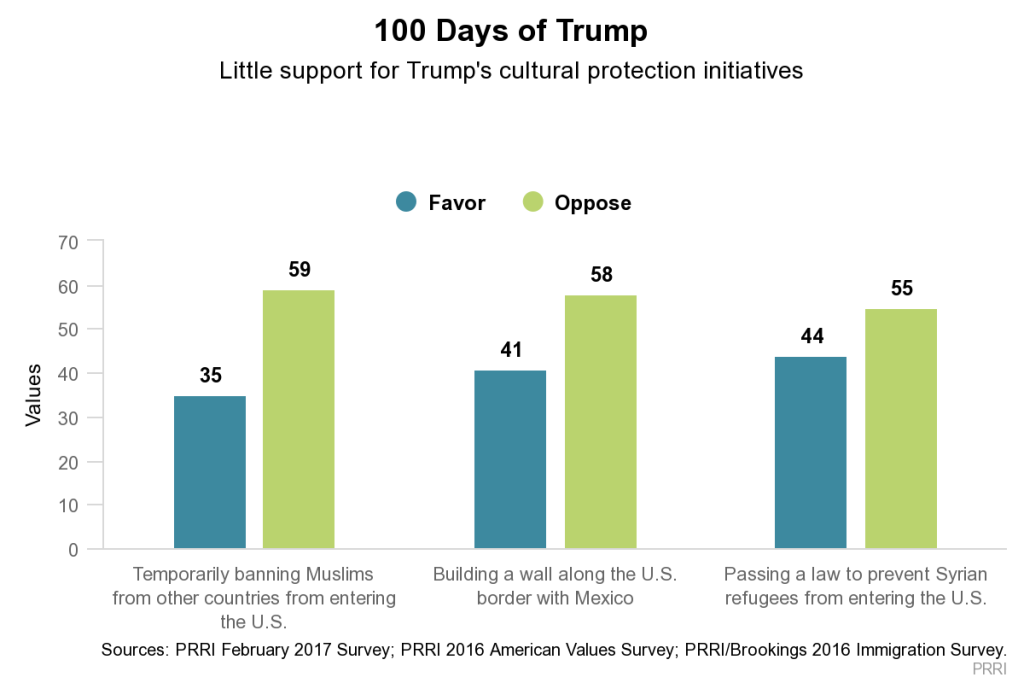President Trump nears his 100-day benchmark in office and he’s already signed nearly 70 executive actions. Some have been signed without much fanfare; others have sparked mass protests and challenged as unconstitutional. Below, we’ve highlighted several key actions—and included findings on where Americans stand on the issues.
 Banning visitors from seven majority-Muslim countries, and indefinite acceptance of refugees from Syria.
Banning visitors from seven majority-Muslim countries, and indefinite acceptance of refugees from Syria.
On January 27, President Trump signed an executive order that banned citizens of Iran, Iraq, Libya, Somalia, Sudan, Syria, and Yemen from entering the U.S. for 90 days. Mass protests at airports immediately began and the next day, a New York judge temporarily blocked part of the order. On February 9, the U.S. 9th Circuit Court of Appeals upheld a different temporary restraining order on the ban. Roughly one month later, Trump signed a nearly identical executive order—which was blocked by a Hawaii judge before it could go into effect. What Americans think: Only about one-third (35 percent) of the public favor a policy that would temporarily ban Muslims from other countries from entering the U.S. Roughly six in ten (59 percent) Americans oppose such a ban. Sixty-five percent of Republicans favor such a ban, while nearly nine in ten (87 percent) of Democrats oppose it. A majority (55 percent) of Americans oppose passing a law that would deny Syrian refugees entrance to the U.S., compared to fewer than half (44 percent) who support it. Seventy percent of Democrats oppose such a law, while 66 percent of Republicans approve.
Increasing immigration patrol numbers and building a wall along the U.S.-Mexico border.
The White House instructed the Department of Homeland Security to “build a large physical barrier on the southern border” in an memo on January 25. What Americans think: Roughly six in ten (58 percent) of Americans oppose building a wall along the U.S.-Mexico border, while roughly four in ten (41 percent) support it. Roughly three-quarters (73 percent) of Republicans favor this policy compared to fewer than four in ten (38 percent) independents and only about one in five (19 percent) Democrats.
Expanding the number of people eligible for deportation and cutting federal funding to so-called “sanctuary cities.”
Trump’s new immigration enforcement policies allow federal officials to find, arrest, and deport immigrants living in the U.S. illegally regardless of whether they have a criminal record. Trump’s attempt to cut funding to sanctuary cities was halted April 25, after San Francisco and neighboring Santa Clara county sued over its constitutionality. What Americans think: There is no state in the country in which a majority prefers deportation over citizenship or permanent residency as the solution for immigration reform. And not even most conservative Republicans, or states the voted overwhelmingly for Trump, support deportation—majorities support a path to citizenship. Most (64 percent) Americans say immigrants living in the U.S. illegally should be allowed a way to become citizens, provided they meet certain requirements; 15 percent say they can become permanent residents but not citizens; and 16 percent say they should be identified and deported.
Trade and manufacturing deals: Withdrawing from the Trans-Pacific Partnership, reducing regulations on U.S. manufacturing, and signing “Buy American, Hire American” order.
When President Trump formally withdrew from the TPP on January 23, he called it a “great thing for the American worker.” The next day, Trump signed a presidential memorandum aiming to reduce red tape in and jumpstart manufacturing projects in the country. And Trump continued to prioritize American workers on April 18, when he signed the “Buy American, Hire American” executive order, which directs federal agencies to propose stricter limits on the H-1B visa program and to enforce guidelines that prioritize American companies and products. What Americans think: Americans are closely divided about the benefits of free trade: 43 percent say free trade agreements are mostly helpful because they open markets for U.S. companies and allow Americans to buy goods more cheaply; 50 percent say free trade agreements are mostly harmful because they send jobs overseas and drive down wages in the country. Republicans are more likely to say they’re harmful (64 percent), while Democrats are more likely to say they’re helpful (54 percent). There are stark divisions among white Americans by class on this issue: 60 percent of the white working class say these deals are harmful, compared to 42 percent of white college-educated adults who say the same.
Dismantling many of President Obama’s climate protections.
The order mandated the review of the Clean Power Plan, which caps power plant’s CO2 emissions. What Americans think. Most (57 percent) of Americans are in favor of stricter limits on the amount of carbon dioxide that power plants and other industrial facilities can release, even if it raises the prices of goods and services. That includes 55 percent of independents and 70 percent of Democrats. And Republicans are divided: 47 percent favor stricter limits while 48 percent oppose them.
Approving the Dakota Access and Keystone XL pipelines.
In one of his first acts as president, Trump signed executive orders advancing the DAPL and the Keystone XL pipelines, pledging both would be constructed using American steel. Trump called it a “great day” of jobs—but new reports show the Keystone XL would only create 35 permanent jobs and would not be built with American steel. What Americans think: A slim majority (52 percent) of Americans support the building of the Keystone XL pipeline, but there are notable party divides: 71 percent of Republicans support construction, while only 42 percent of Democrats say the same.
Featured image by Michael Vadon/Flickr.
